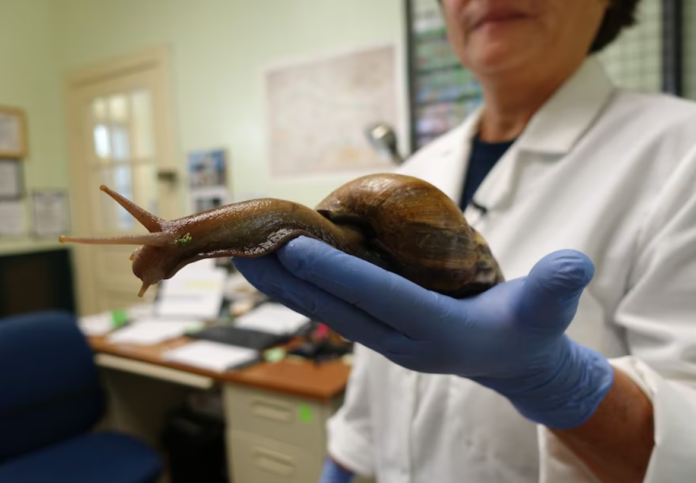
Florida might be known for its alligators and sharks, but this week, a slower, slimier creature is wreaking havoc on Sunshine State residents: a snail.
An area of Broward County, near Fort Lauderdale, enacted a quarantine after the invasive giant African land snail was detected there this month.
Under the quarantine, which covers about 3.5 square miles, it is illegal to move the snail or any vegetation, soil, debris, compost or building materials, “within, through or out of” the area without a compliance agreement, a statement from the Florida Department of Agriculture says.
Despite how it sounds, the quarantine does not prohibit people from leaving their homes — though the presence of a snail as big as a banana might do that on its own.
The U.S. Agriculture Department calls the giant African land snail “one of the most damaging snails in the world” for a reason. It can carry dangerous specimens, including salmonella, bacteria and rat lungworm, which can cause meningitis. It can also cause structural damage to buildings by eating through stucco and plaster. And in Florida, where there is a large agriculture industry, the snail could even pose a threat to food security, the U.S. Geological Survey says.
Robert Cowie, a research professor at the University of Hawaii who studies the biology of snails and the diseases they carry, says that whether giant African land snails can spread worms through mucus remains an open question, but you should refrain from touching them with your bare hands. You should also, of course, not eat them — or risk your dog or child doing so.
“They’re potentially dangerous from the disease perspective,” said Cowie, who lives in Hawaii, where the snails are an established presence. They’re also “an enormous nuisance,” he said, “in terms of eating all your plants in your yard, climbing up the walls of your house, pooping everywhere. They just make a mess.”
When the giant African land snail first appeared in southern Florida in the 1960s, it took 10 years and a million dollars to get rid of it, according to the U.S. Agriculture Department. In October 2021, after another intensive, decade-long effort that included snail billboards, snail-sniffing dogs and even a snail detection hotline, Broward and Miami-Dade counties celebrated removing 160,000 snails and finally eradicating the pest.
A year and a half later, Broward County is fighting the slugger yet again. And they’re not in it alone. Part of Lee County, which includes Fort Myers, enacted a quarantine in March, and part of Pasco County, north of Tampa, announced one last June.
An unusual snail named Jeremy finally found a mate. Now he is stuck in a love triangle.
Identifiable by its brownish, striped shell, the giant African land snail is not your typical garden snail. It is, well, giant — measuring up to eight inches.It can weigh up to 2.2 pounds, and it eats voraciously to support such a mass — able to feed on 500 kinds of plants, including peanuts, beans and melons. It reproduces rapidly — 1,200 eggs a year — and can live as long as a decade.
The snail is, in fact, so large that it is disqualified from competing in the World Snail Racing Championships, according to National Geographic.
Though native to East Africa and nonmigratory, the snail has made its way around the world, including to other parts of Africa, Hawaii, the Pacific islands, the Caribbean, Brazil and much of subtropical Asia.
The snails were so populous in Hawaii in the 1950s, Cowie said, that during rainstorms, they crowded onto the highways and cars would slide on their mucus.
In some cases, the snail may have hitched a ride on cargo, but people may have also illegally transported the snail to sell as a pet or food.
In 2010, a religious group leader was investigated for smuggling the snails into Florida and encouraging his followers eat their mucus, the Miami New Times reported, possibly contributing to the spread of the snails.
It’s not clear how long it will take to rid the Florida area of the persistent pest. Officials are treating the area with metaldehyde, a pesticide that disrupts mucus production and inhibits a snail’s mobility, bringing it — hopefully — to a final stop.
MORE:






